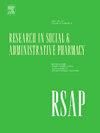Pharmacists’ barriers and enablers to delivering health behaviour recommendations for patients with behavioural determinants of disease: Application of the COM-B model
IF 2.8
3区 医学
Q1 PUBLIC, ENVIRONMENTAL & OCCUPATIONAL HEALTH
Research in Social & Administrative Pharmacy
Pub Date : 2025-07-15
DOI:10.1016/j.sapharm.2025.07.004
引用次数: 0
Abstract
Background
Pharmacists are among the most trusted and accessible health professionals in Australia. Community pharmacists are well positioned to deliver brief health recommendations to reduce risk factors of communicable and non-communicable disease during patient interactions. However, effective facilitation of these interactions in pharmacy practice should be considered. The Capability, Opportunity, Motivation and Behaviour (COM-B) model provides a framework to map understanding of the factors affecting pharmacists’ delivery of health behaviour recommendations to patients, with the aim of reducing disease risk factors.
Methods
Thirteen semi-structured interviews were conducted with Australian community pharmacists (Mage = 38.7 years, SD = 15.6). Participants described their barriers and enablers to delivering brief health behaviour change recommendations during patient counselling. Transcripts were analysed using reflexive thematic analysis, with the COM-B model as a guiding framework.
Results
Three themes were identified: ‘Perceptions of patient willingness’, ‘Professional Role and Identity’, and ‘Structural constraints in pharmacy practice.’ Pharmacists reported being motivated to engage with patients about behaviour change but felt inhibited by retail-models of pharmacy, time constraints, and lack of experiential learning. A patient-centred pharmacy model, theoretical knowledge of behaviour change, proprietor support, and patient interest appeared to be instrumental in the effective facilitation of behaviour change advice.
Discussion
Pharmacists are reportedly motivated to engage with patients about health risk factors and disease management. However, external barriers to recommendations and lack of time may only be reduced with management support. Findings necessitate pharmacy model-level initiatives to effectively overcome barriers, such as educating pharmacists about the benefits of behavioural medicine, and training in brief behaviour change techniques through professional development opportunities. Behavioural medicine can enhance pharmacists’ capacity to support individuals in managing chronic and communicable disease, but this may need to be incorporated and prioritised early in pharmacy training, including throughout tertiary pharmacy curricula.
药剂师在向具有疾病行为决定因素的患者提供健康行为建议方面的障碍和推动因素:COM-B模型的应用。
背景:药剂师是澳大利亚最值得信赖和最容易获得的卫生专业人员之一。社区药剂师有能力提供简短的健康建议,以减少在与病人互动期间发生传染性和非传染性疾病的风险因素。然而,应考虑在药学实践中有效促进这些相互作用。能力、机会、动机和行为(COM-B)模型提供了一个框架,以了解影响药剂师向患者提供健康行为建议的因素,目的是减少疾病风险因素。方法:对澳大利亚社区药师进行13次半结构化访谈(年龄38.7岁,SD = 15.6)。与会者描述了他们在病人咨询期间提出简短的健康行为改变建议时遇到的障碍和促成因素。以COM-B模型为指导框架,采用反身性主题分析对转录本进行分析。结果:确定了三个主题:“患者意愿的感知”,“专业角色和身份”和“药房实践中的结构性约束”。药剂师报告说,他们有动力与患者进行行为改变,但由于药房的零售模式、时间限制和缺乏经验学习,他们感到受到抑制。以患者为中心的药房模式、行为改变的理论知识、经营者的支持和患者的兴趣似乎有助于有效促进行为改变建议。讨论:据报道,药剂师积极参与与患者有关健康风险因素和疾病管理。然而,只有在管理层的支持下,才能减少建议的外部障碍和缺乏时间。研究结果需要药房模式层面的举措来有效地克服障碍,例如教育药剂师行为医学的好处,以及通过专业发展机会进行简短的行为改变技术培训。行为医学可以增强药剂师支持个人管理慢性病和传染病的能力,但这可能需要在药学培训的早期,包括在整个高等药学课程中纳入和优先考虑。
本文章由计算机程序翻译,如有差异,请以英文原文为准。
求助全文
约1分钟内获得全文
求助全文
来源期刊

Research in Social & Administrative Pharmacy
PUBLIC, ENVIRONMENTAL & OCCUPATIONAL HEALTH-
CiteScore
7.20
自引率
10.30%
发文量
225
审稿时长
47 days
期刊介绍:
Research in Social and Administrative Pharmacy (RSAP) is a quarterly publication featuring original scientific reports and comprehensive review articles in the social and administrative pharmaceutical sciences. Topics of interest include outcomes evaluation of products, programs, or services; pharmacoepidemiology; medication adherence; direct-to-consumer advertising of prescription medications; disease state management; health systems reform; drug marketing; medication distribution systems such as e-prescribing; web-based pharmaceutical/medical services; drug commerce and re-importation; and health professions workforce issues.
 求助内容:
求助内容: 应助结果提醒方式:
应助结果提醒方式:


